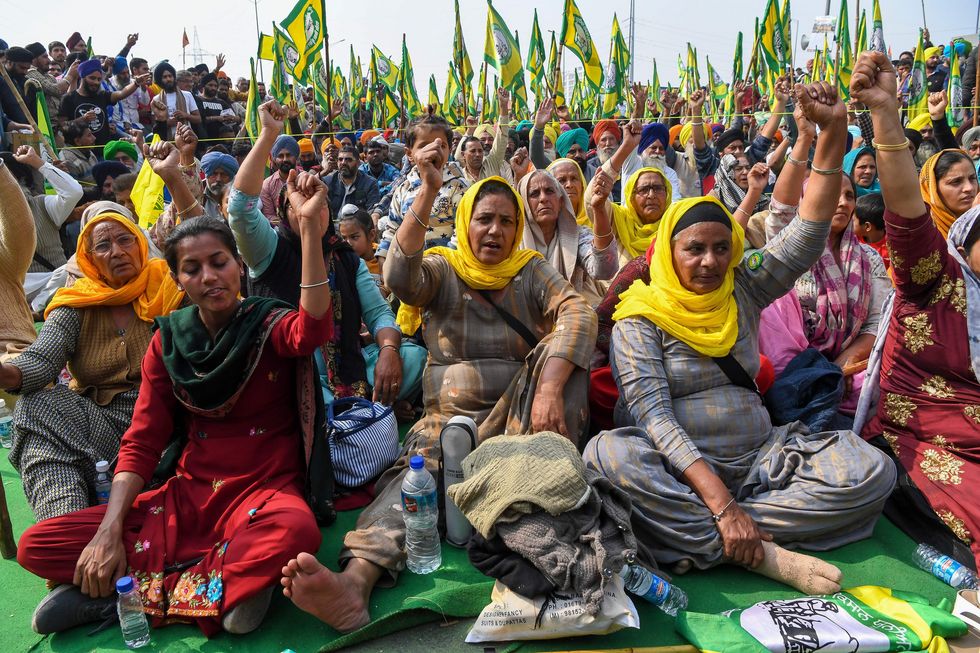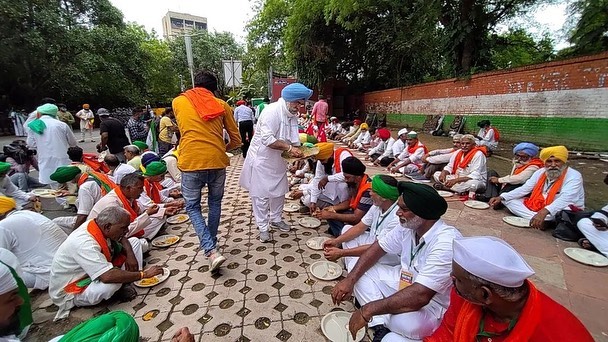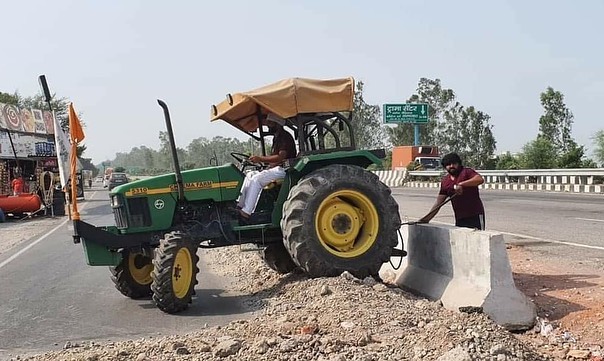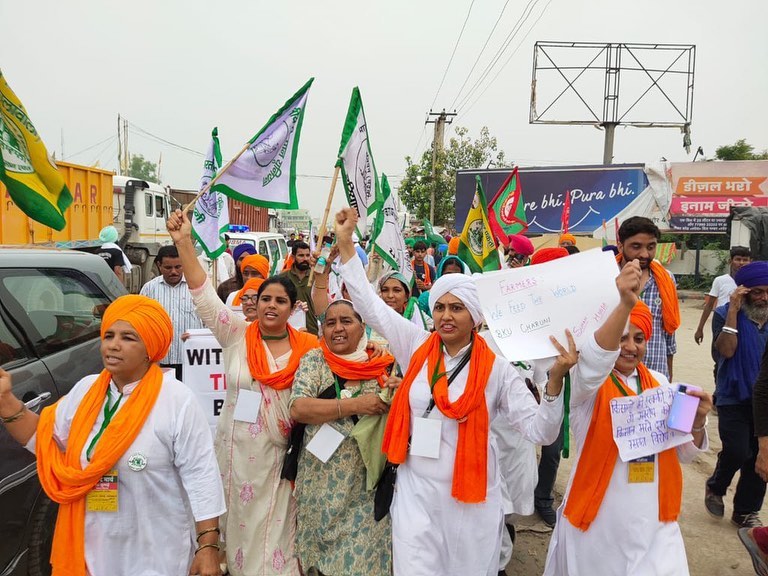We were honored to speak with the Trolley Times on their work documenting the Farmers’ Protests of India.
What follows is a conversation on why this is a world-historic movement, and how other global movements can find inspiration in the struggle of India’s farmers.
Asia Art Tours: For those who may be new to the struggle. Could you briefly discuss what the farmers (and other citizens) in India are fighting against in these ‘Farmers’ Protests’? And why is this struggle important not just for India, but for the whole world?
Trolley Times: The current protest is in continuation of protests in Punjab state since September 2020 when the central government passed 3 farm laws, namely – Farmers’ Produce Trade and Commerce (Promotion and Facilitation) Act, 2020; Farmers (Empowerment and Protection) Agreement on Price Assurance and Farm Services Act, 2020, and the Essential Commodities (Amendment) Act, 2020. The first two laws push the farming sector into the hands of corporate houses with no wherewithal of whatever little safety, security and assurance the existing system has.
Remember, since the economic liberalization happened in India, thousands of farmers commit suicide per year 1, in the year 2019 farm sector accounted for 7.4 percent of total suicides in India. Also, agriculture is the biggest job provider in the country. The third law essentially jeopardizes the food security of the people as it legalizes the stocking of essential items for private corporations and hence they can control prices of essential food items like wheat flour, cornflour and pulses. Not in the distant past, we have seen people dying of hunger during lockdown. So these bills are of severe concern to everyone in India and abroad who agree that as a human being, access to food, decent return to their labour is the bare minimum every country should and must provide to their citizens.
 Photo of Farmers organizing, from issue 1 of the Trolley Times
Photo of Farmers organizing, from issue 1 of the Trolley Times
The farmers are leading a mass movement for the livelihood and the food security of the majority of India, which happens to be home to 1/6th of the world population. Also, these laws are not specific to India. As a policy framework they have been pushed by global monetary institutions like the IMF, World Bank upon most of the developing countries. And even in developed countries, pandemic led lockdown has exposed the glaring inequality and hunger. From this perspective, the whole world should stand up with this movement. If anything that the pandemic has taught us, it is this, “No one is safe, until each of us is safe”.
Moreover, the financial institutions in the Global North, are okay with providing tax payers money to the big agro businesses, but they want developing countries to cut the public support to the mass agrarian community and pave way for big agribusiness to take over and put people out of agriculture force them into precarious labour market of mega cities, where there are safety nets. This phenomenon has happened almost everywhere, and the Indian farmers are looking at their abysmal prospects in the city labour market; hence resisting the imposition of these farm laws.
 Image of female farmers protesting, from issue 21 of the Trolley Times.
Image of female farmers protesting, from issue 21 of the Trolley Times.
Asia Art Tours: Could you explain how the state of India’s Journalism has declined to the point where something like the Trolley Times needs to exist? How has Mass Media in India tried to discredit the protests, and how has the Trolley Times emerged to ensure that the protesters’ perspective is heard over the IT cells and Arnab Goswami’s of India?
Trolley Times: In India, after the right wing BJP government came to power, the corporate owned media became its mouthpiece. Majority of media houses are owned by private corporations close to BJP. Any one resisting the imposition of right wing agendas is hounded. Yet, the farmers are undeterred by whatever labels the media houses or the BJP governments throw at them. In fact the farmers dealt very creatively with their portrayal, if they were termed Khalistani2 terrorists, immediately they started showing placards “I am a farmer, not a terrorist” or “We are guardians of the nation when at international borders but termed terrorist when we ask for our rights”. They also banned entry to the protest sites for rabid pro regime channels like Zee News, Aaj Tak and Republic TV. They showed them placard like “Godi3 Media Go Back” In December 2020, the situation was such that these media channels had to hide their logos from mics even if they were to report from the protest site.
The Trolley Times came out in such an environment. It was celebrated by farmers’ own media. People felt a sense of pride by their association with it. At Trolley Times we have realized that mere criticism of mainstream media will not suffice. And please note that, Trolley Times may have certainly come out in the backdrop of corporate media becoming a government’s mouthpiece, but we are not just here to counter them or fact-check them. We are here trying to do what good journalism ought to do. It’s creation, not just reaction that drives us, the creation of democratic, constitutional and egalitarian ethos.
Beyond print, the Trolley Times has countless videos documenting the protests. Here, teacher Navjot Singh discusses how he came to join the Farmers Movement.
Asia Art Tours: For the Farmers’ Protests and movements globally, in an era of social media why are newspapers/zines/other print media still important for movements?
The Trolley Times: It is the era of digital media, but agricultural and rural communities in India still depend on print newspapers and magazines for news. In rural communities there is a culture of reading newspapers in a small group and to discuss the affairs of the day. Although everyone has phones, for serious news people prefer print. As the protests moved from their own areas to the borders of Delhi state, a stretch of around 15 kilometers was occupied by protests in their tractors and trailers. In Punjabi Hindi, the trailers are called trolleys. So Trolley Times was brought out to replicate the culture of communal reading and we also brought out news from various other protest sites. Not only that, the publications become an archive of the snapshot of this historic movement. It will be an important source for students of the social sciences, politics and history in the coming future.
In this Trolley Times interview, Balwinder Singh discusses the physical sacrifices he’s made to support the Farmers Movement.
Asia Art Tours: I’ve appreciated the poetry, cartoons, academic superstars and humble snapshots of protesters that you’ve included in the Trolley Times. Could you discuss why you feature such diverse media?
The Trolley Times: We are a small team of activists, visual artists and writers. None of us is a trained journalist. That gives us more freedom and a fresh approach to bring out this newsletter. So we make space for articles for every kind of readership. Scholarly essays on the movement, ground reports from various protest sites, testimonials, illustrations, photographs, cartoons, profiles of unions and protesters. It is published in the two most spoken/read languages at the protest sites: Punjabi and Hindi.
Scholarly essays/reportage appeal to the learned reader, whereas artwork, testimonials and cartoons appeal to the common reader. So there is a balance of content for the readers of all age groups, education levels. Since there is appealing cover design in every issue. It attracts even the non readers to start reading.
It is not that there are no other news sources, Punjabi language newspapers are also available at the protest sites. We try not to duplicate what the newspapers or TV/digital media news sources are doing. TV/Digital media has to go after relatively sensational content. Newspapers have to bring all kinds of news. They also have more resources. We on the other hand do what we can do best. Which is to be complementary to those news streams as well. To bring out under reported stories of the protesters. To excavate the heterogeneity and the solidarites in the ongoing movement.
 Artwork from Trolley Times article by the poet Rupi Kaur.
Artwork from Trolley Times article by the poet Rupi Kaur.
Asia Art Tours: Could you discuss some of the main principles of the Farmers Protest, (non-violence, Langar, Mutual Aid) and discuss where the inspiration for these principles come from?
The Trolley Times: The Sikh religion in itself was born out of protest against the Mughal Rule. The Sikh history is a history of struggle against the landlords/ruling elite of the times, and which brought the rights to own land and carry arms to the peasantry and the working castes.
Most of the unions take inspiration from Punjabi Sikh History of struggle and the workers’ struggles’ around the globe. There is no clear segregation of secular/non secular ideas among the protesters. It is more common to see the yellow Sikh religious flags along with the Green/Red flags of peasant/labour unions.
Non Violence has been a principle in Sikhi and in the Indian Freedom struggle. Punjab has had a history of violent struggles as well. A peasant agitation in Haryana two years ago also resulted in violence. The Unions in Punjab are very well organized and they know from their experience in fighting struggles for better compensation for crops in states to be non violent and pressurise the government to give in to their demands. They are inspired by principles in Sikh History/ Indian Freedom Struggle.
 Farmers eating the communal meal of Langar. From the Trolley Times Instagram
Farmers eating the communal meal of Langar. From the Trolley Times Instagram
Langar has been a significant aspect of the Sikh faith. Which is enshrined in the tenets of the faith to provide food and support to everyone irrespective of their caste, creed and religion. Mutual aid and support is an aspect of the rural/farming communities. So irrespective of the religion the protests have been supported by all castes/religious groups. The most common solidarity is between Hindu peasants of Haryana and Sikhs of Punjab. There has been mobilisation in muslim majroty areas of Haryana and UP as well. Some of the farmers unions have reached out in support of Muslim community in the CAA/NRC protests as well. Which is under attack by the ruling right wing government and its footsoldiers. This is both an inspiration from Sikhi and the left wing tradition of fighting for the oppressed. The muslim community has been supportive by taking out langar. In Tikri, a Hindu temple has given space to Sikh protesters.
It is their own history they are taking inspiration from, be it the movements by the tenant farmers against the landlords, the various peasant struggles against the British Colonial Government, the struggles by the Sikh peasantry against the landlords during the Mughal rule and so forth. The common refrain is we have fought to become owners of these farmlands and we will fight to safeguard it from corporate takeover It is not that the farmer leadership and student activists are not aware of the global social movements. The world working women’s day was celebrated at the protest sites. May Day was celebrated. But the common protesters are more engaged with the cause from their knowledge of immediate history.
Farmers protesting at the Tikri border, blocking critical roads connecting India’s capital to the rest of the country. From the Trolley Times Youtube.
Asia Art Tours: How have other global movements (Hong Kong, Thailand, Black Lives Matter, Yellow Vests, Sudan, Algeria, Chile, Xinjiang) who have influenced or provided inspiration for the Farmers Protests?
Trolley Times: It is their own history they are taking inspiration from, be it the movements by the tenant farmers against the landlords, the various peasant struggles against the British Colonial Government, the struggles by the Sikh peasantry against the landlords during the Mughal rule and so forth. The common refrain is we have fought to become owners of these farmlands and we will fight to safeguard it from corporate takeover4. It is not that the farmer leadership and student activists are not aware of the global social movements. The world working women’s day was celebrated at the protest sites. May Day was celebrated. But the common protesters are more engaged with the cause from their knowledge of immediate history.
Asia Art Tours: India recently saw a powerful series of protests around the issues of CAA/NRC. Do you see the Farmers Protests as standing in solidarity with other persecuted groups within India (Muslims, Adivasis, Migrant Laborers)? If so, can the Farmers Protests build solidarity with these groups to grow this movement beyond a protest against agricultural laws?
Trolley Times: This movement definitely started against the three farm laws but any democratic movement of this scale cannot limit itself to just demands. The protests are itself a process where people from different caste, class, gender, region and religion come together precisely because they can’t find these battles in their individual capacities or the issue affects more than one group of peoples. In that sense this protest are also beyond just three farm bills. People from all walks of life are supporting this movement from across the world. There are farm labour unions, Dalit organizations, muslim farmer groups and civil society member, who are part of the movement. So i would take a step ahead and say the movement is not just in solidarity with them but they are an integral part of the movement. For adivasis, the concept of agriculture cannot be divorced from forestry. And the majority of farm workers are women but that doesn’t come as a first image when we think of farmers. So all these questions have been foregrounded in this movement.
 Farmers using tractors to remove barricades put up police attempting to stop the forward march of the protests. From the Trolley Times Instagram.
Farmers using tractors to remove barricades put up police attempting to stop the forward march of the protests. From the Trolley Times Instagram.
Remember, punjab is one of the few states where Non-Muslims also protested against CAA-NRC because they recognize that they are also a minority and a Hindu natuonalist govt which abhor the constitution is not going to stop with just Muslims. And this time when the farmer protesters were termed as khalistani, their apprehensions came true. In short, any group which speaks for their right that doesn’t fall in the govt. line of argument is termed as anti-national. And this tribe has been increasing since 2014; first students, then dalits, muslims, workers, oppositional political parties and now farmers. The process of passing the law itself was unconstitutional. So this is a mass movement for restoration of democratic ethos in the society and that democratization may lead to a more comprehensive counter to govt. sectarian and anti-people policy. It already is a movement that offers a vision of a more just and egalitarian society.
Asia Art Tours: In many issues of the Trolley Times, you pay homage to the martyrs of the Farmers Protests. Why does the paper make a point to center these martyrs? And if we too want to pay homage, respect or ‘pay it forward’ for these martyrs, what can those abroad do to support the movement?
Trolley Times: We acknowledge the sacrifices the protesters are making by being there at the protest sites. And to lose one’s life in struggle is the biggest sacrifice. So we pay our homage.To contribute to our movement particularly whoever can, shall come and learn from the protesters how they are resolute in their fights for their rights and how they have fought every attack by the pro corporate media and right wing majoritarian government.
The Trolley Times recently produced a video, asking for reader support. If you enjoyed our interview today, please consider donating to their publication.
What the current farmer protests have done is bring issues of agriculture, labour and rural communities to the fore. When the media and policy narratives follow finance capital, tech and big business. In spite of op eds by pro corporate pro government “thinkers”, media and government downplaying it; the concerns of protesting farmers and labourers are being asserted. It has become a concern here in India and it should be a concern globally. An engagement with fights for fairer systems for labours, farmers and rural communities wherever you are is a fight worth joining.
Asia Art Tours: Lastly, within India, what has the public reaction been to the the Trolley Times?
The Trolley Times: The public reaction to Trolley Times has been overwhelmingly positive. On the day of its launch, It was the main story at NDTV Hindi prime time programme hosted by Ravish Kumar5.We became a national sensation. The diaspora took note and volunteered to translate. First five issues were also produced in English translations6 with the contributions from volunteers. We were contacted for Bengali, Marathi, and Kannada translations. Digital Editions were distributed in Shamukhi Script7in Pakistani Punjab as well. Which were produced and distributed. People in Punjab state’s Jalandhar, Bathina, and Fatehgarsh Sahib, printed and distributed the copies by themselves. Copies were also distributed In Melbourne, San Francisco, London and Vancouver. Scholars wanted to subscribe.
Subsequently we have been featured by a number of news reports8, magazine articles9, podcasts10, video reports and documentaries. Our writings have been cited in scholarly essays11 on the movement. Our editorial team members have been invited to various discussions12 hosted by national and international media institutions, universities, and international student bodies. It almost became a challenge to do both, run the weekly newsletter, and engage in the exigencies of the media reports about us, yet, we stretched ourselves to do it since it was for the farmers’ movement.
 Female Farmers marching to demand justice. Image provided by the Trolley Times.
Female Farmers marching to demand justice. Image provided by the Trolley Times.
Interview answers provided by Jasdeep Singh, with inputs from Mukesh Kulariya & Navkiran Natt. All are part of the Trolley Times Editorial team.
For more on the Trolley Times please visit their website and their social media channels
Footnotes
- “Every Day, 28 People Dependent on Farming Die by Suicide in India.” Downtoearth.org.in, 2014, downtoearth.org.in/news/agriculture/every-day-28-people-dependent-on-farming-die-by-suicide-in-india-73194. Accessed 8 July 2021.
- A movement for Sikh separate homeland Khalistan in the eighties. In 1984, the Indian government sent an army to quell Sikh militants in the Golden Temple (holiest shrine of the Sikhs), and demolished parts of the historic sacred space with tanks and bombshells Which resulted in a swell of militancy in the region. In the same year then Prime Minister Indira Gandhi was assassinated, and subsequently the ruling party Congress, orchestrated a pogrom of the Sikhs in Delhi.
It took 10 more years that the militancy in Punjab state was neutralized with extra judicial killings by security forces and forcing the majority of the surviving militants to move abroad.
- Godi means lap. It rhymes with Prime Minister Modi as well. So a media in the lap of PM Modi and his cronies.
- Sangeet Toor. “A Century Apart, Currents of Dissent Bridge the Farmers’ Protests and the Muzara Movement.” The Caravan, 25 Feb. 2021, caravanmagazine.in/commentary/farmers-protests-muzara-movement-punjab-land-rights. Accessed 2 Aug. 2021.
- Volunteers launch newsletter ‘Trolley Times’ for protesting farmers https://www.youtube.com/watch?v=EWJaveSzu_0
- Download Link For English Issues https://drive.google.com/drive/u/0/folders/1bikH2CrD_9IQvKk9gQZoifPa6TwnwoEE
- Both Pakistan and India share the erstwhile United Punjab state/British Punjab/Sikh Empire. The language is Punjabi, on the Pakistani side it is written in Perso Arabic script called Shahmukhi, and on Indian side it is written in Indic script called Gurmukhi. Trolley Times publishes Punjabi Gurmukhi script and Hindi in Devanagri script.
- Priya Ramani. “The Country’s Fastest-Growing Newspaper.” BloombergQuint, Bloomberg Quint, 23 Dec. 2020, www.bloombergquint.com/opinion/trolley-times-the-countrys-fastest-growing-newspaper. Accessed 2 Aug. 2021.
- Tanushree Bhasin. “How Cultural Initiatives Nurture Collective Activity at the Farmers’ Protests.” The Caravan, 31 Jan. 2021, caravanmagazine.in/media/trolley-times-collective-activity-farmers-protests. Accessed 2 Aug. 2021
- “The Trolley Times with Jasdeep Singh | SikhArchive.” SikhArchive, 2021, sikharchive.transistor.fm/episodes/the-trolley-times-with-jasdeep-singh. Accessed 2 Aug 2021.
- Tanya Singh, Pritam Singh & Meena Dhanda (2021) Resisting a “Digital Green Revolution”: Agri-logistics, India’s New Farm Laws and the Regional Politics of Protest, Capitalism Nature Socialism, 32:2, 1-21, DOI: 10.1080/10455752.2021.1936917
- Solidarity, Asia. “Fighting Corporate Power & Fascist Governments: India and Beyond.” YouTube, 27 Jan. 2021, www.youtube.com/watch?v=QjzCjV2Z2Z0. Accessed 2 Aug. 2021
